With that glorious scent, and unusual habit of flowering and fruiting at the same time, it’s no surprise that citrus plants are often the first choice to grow in a home greenhouse. To discover the best tips for success, this month I’m turning to Sam Hubert, Nursery Manager for the West Coast mail-order company, One Green World.

It’s All About Drainage
Citrus in a greenhouse will be growing in containers, so my first question for Sam—which ones work best? “It’s really about drainage. Many containers, especially decorative ones, don’t have enough holes to allow water to quickly drain away.” If yours doesn’t, you can drill more holes. Or, Sam suggests, “Black plastic pots are fine. They hold heat well. Just slip them into another, more decorative container.”
Check the Rootstock
And when potting to the next size up, only add an inch or two more in diameter over the last container. That’s because, Sam tells me, many citrus are grown on a dwarf rootstock. “One Green World uses Flying Dragon,” Sam says. That makes the plants slower to put on growth, so they won’t gallop out of their root space. Slow growers don’t need many extra inches of empty soil that will hold too much moisture.
Plant in Coarse Acidic Potting Mix
Any freely draining soil is good for citrus, and you can buy bagged citrus mixes. You can also buy citrus plant food. Follow the directions on box or bag. Of the three main numbers, look for the second one to be higher for good fruit productions, such as 4-6-3. Or use a timed-release fertilizer that feeds for up to nine months.

Water Sparingly
All this emphasis on good drainage is important. “The quickest way to kill a citrus plant is to overwater it,” Sam says. “Let it dry out between waterings.” It’s time to water when the topsoil is dry an inch down. With smaller containers, add water when they feel lighter as you lift them, “But you don’t want to wait for anything to wilt,” Sam adds. And citrus will need less water in winter, when, even if they have fruit, they are usually resting until spring flowering. “You could water only once a week or once every two, depending on the temperature in the greenhouse,”
Send Citrus Outside in Summer

Sam notes, “There is less pest pressure outdoors. And natural pest predators will help you out when the plants are outside.” Under glass, the sun’s strength is only about half, so the plants may need several weeks to make a full transition. Gradually acclimate plants by starting them outdoors in shade and then moving them into more light. This is where a heavy-duty wheeled plant stand comes in handy.
Be Pest Vigilant
The most common pests on citrus are aphids and scale. In the greenhouse, sticky strips can alert you as to what intruders you might have. Sam advises treating with the least harmful first, such as a good water wash-off. If no success, step up to insecticidal soap, and then neem oil. And when you bring your plants in after a summer outside, inspect them thoroughly. “You can rub off little clumps of scale in the larval stage,” Sam says. Always give plants good wash down before returning them to their greenhouse home.
Sam’s Picks for Easy Citrus in the Greenhouse

A bounty of citrus can be grown in a greenhouse Improved Meyer Lemon (Citrus meyeri) – This popular lemon has a long stage of ripening, so you can have multiple crops a year.
- Kishu Mandarin (Citrus kinokuni mukakukishu) – “This one is probably the most fragrant of all, with easy to peel, really sweet, small fruits,” Sam says.
- Makrut Thai lime (Citrus hystrix) – Harvest the spicy leaves year-round while waiting for the fruit, often used in Asian cooking.
- Meiwa Kumquat (Fortunella crassifolia ‘Meiwa’) – Ripens early, Sam says, “with tons of blooms and small fruits.”
- Yuzu Ichandrin (Citrus junos) – This early ripening lemon-lime, Sam says, “is super cold hardy.” That’s good if you don’t want to heat your greenhouse over winter.










